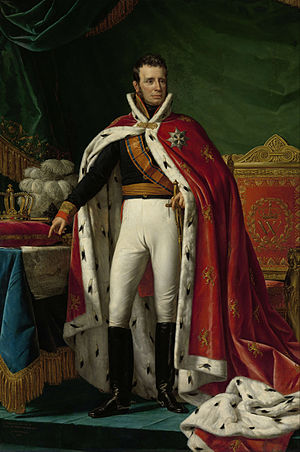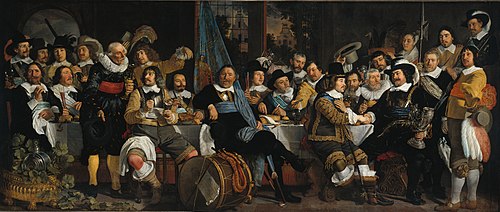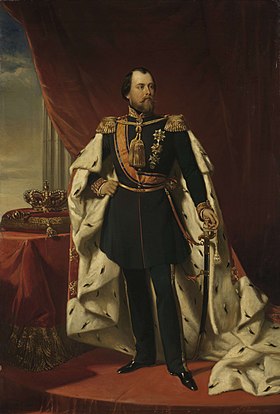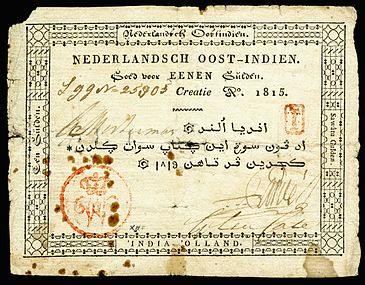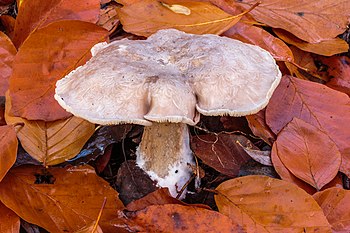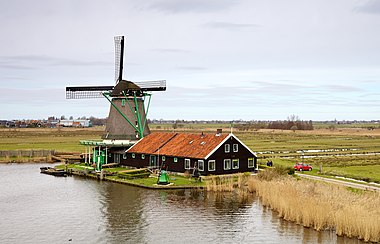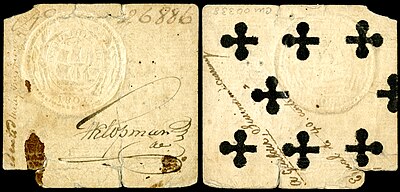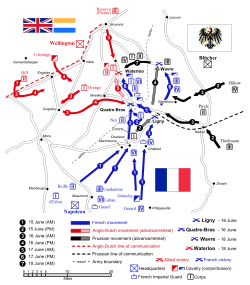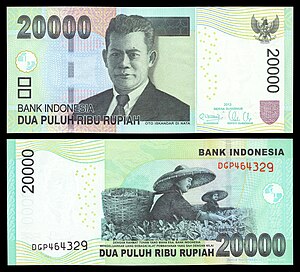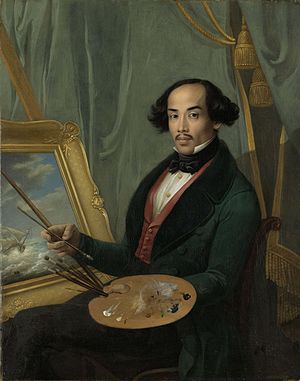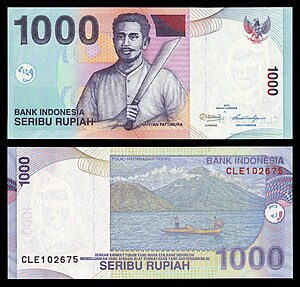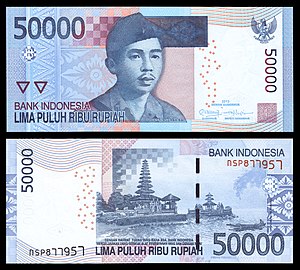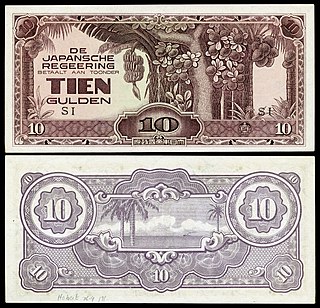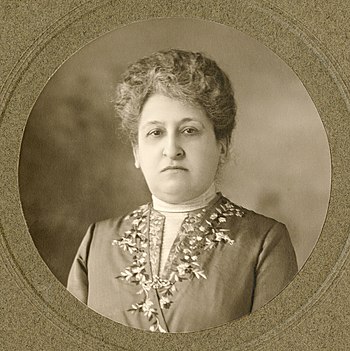Featured pictures list
Template:POTD/2021-11-22
Baby Huwae (22 November 1939 – 5 June 1989) was an Indonesian model, film actress and singer. Born in
Rotterdam, Netherlands, she moved to Indonesia, where she took up modelling, by the 1950s. She entered the film industry in 1958, and gained popularity following the success of
Asrama Dara. Over the next few years, Huwae acted in a further five films and established a girl group, the Baby Dolls, with several actresses who had appeared in her second film. She made a guest appearance in one more film in 1971 after a ten-year hiatus.
Template:POTD/2016-08-24
William I (1772–1843) was a
Prince of Orange and the first
King of the Netherlands and
Grand Duke of Luxembourg. William implemented controversial language policies, founded many trade institutions and universities, and adopted a new constitution. However, the southern Netherlands became increasingly marginalized, and in 1830 the
Belgian Revolution broke out. The war against the newly-declared
Belgium caused considerable economic distress for the Netherlands, and in 1839 William signed the
Treaty of London, which recognized Belgium. William abdicated the following year.
Template:POTD/2010-01-30
Template:POTD/2013-11-29
The
Christmas Flood of 1717 was the most recent large flood in the northern Netherlands, caused by a northwesterly storm that hit the coast of the Netherlands, Germany and Scandinavia on Christmas night of 1717. Approximately 14,000 people drowned. Floodwaters reached the towns and cities of
Groningen,
Zwolle,
Dokkum,
Amsterdam, and
Haarlem. Many villages were devastated in the west of
Vlieland, behind the sea dykes in
Groningen province, and elsewhere.
Template:POTD/2018-02-19
Template:POTD/2017-04-29
Template:POTD/2011-10-14
Template:POTD/2018-05-02
Painting: Herman Antonie de Bloeme
Template:POTD/2018-02-02
Template:POTD/2015-12-18
A banknote for one
Netherlands Indies gulden. This note was issued in 1815 as part of the first Dutch government-issued paper money in the Netherlands Indies. However, in 1818 the issuing bank—De Bank Courant en Bank van Leening—was dissolved due to a lack of capital, and six months later, this first series of notes was declared worthless.
Template:POTD/2016-11-11
Template:POTD/2008-05-14
Template:POTD/2011-07-14
A
self-portrait of
Louis-Marie Autissier (1772–1830), a French-born Belgian
portrait miniature painter. He is considered the founder of the Belgian school of miniature painting in the nineteenth century. Born at
Vannes, in
Brittany, he joined the
French Revolutionary Army at
Rennes in 1791. On leaving the army in 1795, Autissier went to Paris and trained his art by studying paintings at the
Louvre. In 1796 he settled in
Brussels, but continued to divide his time between Belgium, the Netherlands, and France. Although he enjoyed great success in his career, serving as
court painter to
Louis Napoleon, French King of the Netherlands, and later to
Willem I, Autissier died penniless.
Template:POTD/2018-09-25
Cornelis Kruseman (25 September 1797 – 14 November 1857) was a Dutch painter. Born in
Amsterdam, he studied art with
Charles Howard Hodges and
Jean Augustin Daiwaille before moving to Italy via Paris in 1821. He remained in Italy for four years, working with and learning from artists
Jean-Victor Schnetz and
Louis Léopold Robert, and then moved back to the Netherlands and settled in
The Hague. He lived in Italy again from 1841 to 1848, leading him to be called the "Italian Kruseman", before returning once more to the Netherlands for the rest of his life. His works included portraits, biblical scenes, and depictions of Italian peasant life.
This picture is a self-portrait of Kruseman, which hangs in the
Museum Van Loon in Amsterdam.
Template:POTD/2008-05-26
Template:POTD/2021-04-19
Template:POTD/2021-05-30
Clitocybe nebularis, commonly known as the clouded agaric or the cloud funnel, is a common
gilled fungus that grows both in
conifer-dominated forests and
broad-leaved woodland in Europe and North America. This
C. nebularis mushroom was photographed growing among fallen
beech leaves in Famberhorst nature reserve, the Netherlands.
Template:POTD/2016-03-09
A juvenile
pied avocet (
Recurvirostra avosetta) near Oosterend, Texel Island, the Netherlands. While adults are black and white, juveniles of this species have more greyish and sepia tones.
Template:POTD/2016-03-01
Template:POTD/2012-10-30
Template:POTD/2022-04-16
Richèl Hogenkamp (born 16 April 1992) is a professional tennis player from the Netherlands. Her highest
WTA singles ranking is 94, which she reached on 24 July 2017. On the
ITF Women's World Tennis Tour, she has won 16 singles and 14 doubles titles. This photograph depicts Hogenkamp competing at the 2015
Madrid Open.
Template:POTD/2016-06-17
Delftsevaart is a canal in the city of
Rotterdam in the Netherlands. It is seen here on a
photochrom print released around 1900. During World War II, this area of the city was destroyed in the 1940
Rotterdam Blitz, but the
St. Lawrence Church, visible in the background, survived the war.
Template:POTD/2016-02-28
Template:POTD/2011-04-21
A
panoramic view of Grote Werf, a community in the municipality of
Waterland, located on the
Marken peninsula in the
Netherlands. Marken is a
tourist attraction, well-known for its characteristic wooden houses. The island is connected to the mainland by a
causeway and was a separate municipality until 1991, when it was merged into Waterland.
Template:POTD/2020-12-24
Ambrosius Bosschaert (1573–1621) was a Flemish-born Dutch
still-life painter and art dealer. A rising interest in botany and a passion for flowers led to an increase in still-life paintings of flowers at the end of the 1500s in the Netherlands and Germany, and Bosschaert was the first great Dutch specialist in the genre. In this oil-on-copper painting, butterflies, a dragonfly, a bumblebee and a caterpillar are nestled among roses, forget-me-nots, lilies-of-the-valley, tulips and other flowers. The painting is in the collection of the
J. Paul Getty Museum in
Los Angeles, California.
Template:POTD/2015-09-15
Mary of Hungary (1505–1558) was
queen of Hungary and
Bohemia as the wife of
King Louis II. After their short, childless marriage ended with Louis' death, Mary's brother
Ferdinand I came to power and made her regent – and later
governor – of the Netherlands. She created unity between the provinces and was an enthusiastic patron of literature, music, and hunting.
Template:POTD/2012-07-02
Template:POTD/2016-02-06
Template:POTD/2013-06-10
Template:POTD/2007-01-25
Template:POTD/2010-01-09
Template:POTD/2016-10-21
Template:POTD/2009-09-13
Template:POTD/2009-03-23
Template:POTD/2018-01-23
Allegory of Vanity, a
vanitas completed by
Antonio de Pereda between 1632 and 1636. Works in this category of symbolic art, especially associated with
still life paintings of 16th- and 17th-century
Flanders and the
Netherlands, refer to the traditional Christian view of earthly life and the worthless nature of all earthly goods and pursuits. The
Latin noun
vanĭtās means "emptiness" and derives its prominence from
Ecclesiastes. Common symbols in vanitas include skulls, rotten fruit; bubbles; smoke, watches, hourglasses, and musical instruments.
Template:POTD/2012-11-14
Template:POTD/2009-10-27
De Magere Compagnie (completed 1637), which depicts a company of
schutterij, a voluntary
city guard or citizen
militia in the
medieval and
early modern Netherlands.
Frans Hals was commissioned to create this, but he was unable to complete it after three years, and the company hired
Pieter Codde to finish it. Group portraits such as this of
schutterij were known as
schuttersstuk, and were popular among the guards themselves.
Template:POTD/2016-09-22
Card money, printed on plain cardboard or
playing cards, was issued from the 17th to the 19th century to supplement the supply of money in several countries and colonies.
This playing card from
Dutch Guiana (now
Suriname), dated 1801, has a face value of
one guilder. In that colony, card money was first issued in 1761, initially backed by
bills of exchange from the Netherlands; but later it was released unsecured, and
inflation was an issue for much of the currency's lifetime, with the value fluctuating wildly until it was replaced with paper money in 1826 and formally discontinued two years later.
Template:POTD/2007-11-27
Template:POTD/2018-08-18/2
The
rupiah is the national currency of Indonesia. Introduced in 1946 by Indonesian nationalists
fighting for independence, the currency replaced a version of the
Netherlands Indies gulden which had been introduced during the
Japanese occupation in
World War II. In its early years the rupiah was used in conjunction with other currencies, including a new version of the gulden introduced by the Dutch. Since 1950, it has had a
lengthy history of inflation and revaluation. As of August 2018
[update], the currency—which is issued and controlled by the
Bank of Indonesia—is trading for more than 14,600 rupiah to the
United States dollar.
This note, denominated 2,000 rupiah, is part of the 2009 series. It depicts Prince Antasari, a National Hero of Indonesia, on its obverse, and a traditional Dayak dance on its reverse.
See other denominations: Rp 1,000, Rp 5,000, Rp 10,000, Rp 20,000, Rp 50,000, Rp 100,000
Template:POTD/2009-11-29
Template:POTD/2008-06-15
A map of
troop movements during the
Waterloo Campaign, leading up to the
Battle of Waterloo where
Napoleon Bonaparte was defeated. Napoleon's
Army of the North came up against a coalition army composed of forces from the
United Kingdom, the
Netherlands,
Prussia,
Hanover,
Nassau, and
Brunswick. Beginning 15 June 1815, the combatants fought successively in the
Battle of Quatre Bras, the
Battle of Ligny, the Battle of Waterloo, and lastly the
Battle of Wavre.
Template:POTD/2018-08-18/3
The
rupiah is the national currency of Indonesia. Introduced in 1946 by Indonesian nationalists
fighting for independence, the currency replaced a version of the
Netherlands Indies gulden which had been introduced during the
Japanese occupation in
World War II. In its early years the rupiah was used in conjunction with other currencies, including a new version of the gulden introduced by the Dutch. Since 1950, it has had a
lengthy history of inflation and revaluation. As of August 2018
[update], the currency—which is issued and controlled by the
Bank of Indonesia—is trading for more than 14,600 rupiah to the
United States dollar.
This note, denominated 5,000 rupiah, is part of the 2009 series. It depicts Tuanku Imam Bonjol, a National Hero of Indonesia, on its obverse, and a West Sumatran weaver on its reverse.
See other denominations: Rp 1,000, Rp 2,000, Rp 10,000, Rp 20,000, Rp 50,000, Rp 100,000
Template:POTD/2018-08-18
The
rupiah is the national currency of Indonesia. Introduced in 1946 by Indonesian nationalists
fighting for independence, the currency replaced a version of the
Netherlands Indies gulden which had been introduced during the
Japanese occupation in
World War II. In its early years the rupiah was used in conjunction with other currencies, including a new version of the gulden introduced by the Dutch. Since 1950, it has had a
lengthy history of inflation and revaluation. As of August 2018
[update], the currency—which is issued and controlled by the
Bank of Indonesia—is trading for more than 14,600 rupiah to the
United States dollar.
This note, denominated 5,000 rupiah, is part of the 2009 series. It depicts Tuanku Imam Bonjol, a National Hero of Indonesia, on its obverse, and a West Sumatran weaver on its reverse.
See other denominations: Rp 1,000, Rp 2,000, Rp 10,000, Rp 20,000, Rp 50,000, Rp 100,000
Template:POTD/2018-08-18/5
The
rupiah is the national currency of Indonesia. Introduced in 1946 by Indonesian nationalists
fighting for independence, the currency replaced a version of the
Netherlands Indies gulden which had been introduced during the
Japanese occupation in
World War II. In its early years the rupiah was used in conjunction with other currencies, including a new version of the gulden introduced by the Dutch. Since 1950, it has had a
lengthy history of inflation and revaluation. As of August 2018
[update], the currency—which is issued and controlled by the
Bank of Indonesia—is trading for more than 14,600 rupiah to the
United States dollar.
This note, denominated 20,000 rupiah, is from a 2011 revision of an earlier series. It depicts Oto Iskandar di Nata, a National Hero of Indonesia, on its obverse, and Sundanese tea farmers on its reverse.
See other denominations: Rp 1,000, Rp 2,000, Rp 5,000, Rp 10,000, Rp 50,000, Rp 100,000
Template:POTD/2019-11-16
Helleborus orientalis, also known as the Lenten rose, is a
perennial flowering plant and a species of
hellebore in the buttercup family,
Ranunculaceae, native to Greece and Turkey.
Jean-Baptiste Lamarck described the species in 1789, giving it its current name of
Helleborus orientalis ("
Hellébore du Levant"). The species name is derived from the Latin
oriens ('east'). The common name derives from the plant's flowering during
Lent. Within the genus
Helleborus, it has been classified in the section
Helleborastrum, and is closely related to the other eight species in the section. These species are all highly
variable and
hybridise with each other freely.
This picture shows an
H. orientalis flower from the Netherlands, showing swollen
seedpods.
Template:POTD/2015-02-17
Template:POTD/2018-08-18/1
The
rupiah is the national currency of Indonesia. Introduced in 1946 by Indonesian nationalists
fighting for independence, the currency replaced a version of the
Netherlands Indies gulden which had been introduced during the
Japanese occupation in
World War II. In its early years the rupiah was used in conjunction with other currencies, including a new version of the gulden introduced by the Dutch. Since 1950, it has had a
lengthy history of inflation and revaluation. As of August 2018
[update], the currency—which is issued and controlled by the
Bank of Indonesia—is trading for more than 14,600 rupiah to the
United States dollar.
This note, denominated 1,000 rupiah, is part of the 2000 series. It depicts Pattimura, a National Hero of Indonesia, on its obverse, and the islands of Maitara and Tidore on its reverse.
See other denominations: Rp 2,000, Rp 5,000, Rp 10,000, Rp 20,000, Rp 50,000, Rp 100,000
Template:POTD/2009-10-10
Engraver: George J. Verbeck, after Thérèse van Duyl Schwarze
Restoration: Lise Broer
Template:POTD/2018-08-18/6
The
rupiah is the national currency of Indonesia. Introduced in 1946 by Indonesian nationalists
fighting for independence, the currency replaced a version of the
Netherlands Indies gulden which had been introduced during the
Japanese occupation in
World War II. In its early years the rupiah was used in conjunction with other currencies, including a new version of the gulden introduced by the Dutch. Since 1950, it has had a
lengthy history of inflation and revaluation. As of August 2018
[update], the currency—which is issued and controlled by the
Bank of Indonesia—is trading for more than 14,600 rupiah to the
United States dollar.
This note, denominated 50,000 rupiah, is from a 2011 revision of an earlier series. It depicts I Gusti Ngurah Rai, a National Hero of Indonesia, on its obverse, and Bratan Temple on its reverse.
See other denominations: Rp 1,000, Rp 2,000, Rp 5,000, Rp 10,000, Rp 20,000, Rp 100,000
Template:POTD/2017-05-23
Carl Linnaeus (1707–1778) was a Swedish
botanist, physician, and
zoologist, who formalised the modern system of naming organisms called
binomial nomenclature. He is known as the "father of modern taxonomy".
Born in the countryside of
Småland, Linnaeus received most of his higher education at
Uppsala University and began giving lectures in botany there in 1730. He studied abroad between 1735 and 1738, and published the first edition of his
Systema Naturae in the Netherlands. Upon his return to Sweden, he became professor of medicine and botany at
Uppsala. In the 1740s, he was sent on several journeys through Sweden to find and classify plants and animals. In the 1750s and 1760s, he continued to collect and classify animals, plants, and minerals, and published several volumes. At the time of his death, he was one of the most acclaimed scientists in Europe.
Template:POTD/2018-10-18/1
Banknotes: Empire of Japan. Reproduction: National Numismatic Collection, National Museum of American History at the Smithsonian Institution The
Japanese-issued Netherlands Indies gulden was the currency issued by the
Japanese Empire when it occupied the
Dutch East Indies during World War II. Following the Dutch capitulation in March 1942, the Japanese closed all banks, seized assets and currency, and assumed control of the economy in the territory. They began issuing
military banknotes, as had previously been done in other occupied territories. These were printed in Japan, but retained the name of the pre-war currency and replaced the Dutch gulden at par. From 1943 the military banknotes were replaced by identical bank-issued notes printed within the territory, and the currency was renamed the
roepiah from 1944. The currency was replaced by the
Indonesian rupiah in 1946, one year after the Japanese surrender and the country's independence.
This note, denominated one cent, is part of the 1942 series.
See other denominations: One cent · Five cents · Ten cents · Half gulden · One gulden, Five gulden, Ten gulden
Template:POTD/2018-10-18/7
Banknotes: Empire of Japan. Reproduction: National Numismatic Collection, National Museum of American History at the Smithsonian Institution The
Japanese-issued Netherlands Indies gulden was the currency issued by the
Japanese Empire when it occupied the
Dutch East Indies during World War II. Following the Dutch capitulation in March 1942, the Japanese closed all banks, seized assets and currency, and assumed control of the economy in the territory. They began issuing
military banknotes, as had previously been done in other occupied territories. These were printed in Japan, but retained the name of the pre-war currency and replaced the Dutch gulden at par. From 1943 the military banknotes were replaced by identical bank-issued notes printed within the territory, and the currency was renamed the
roepiah from 1944. The currency was replaced by the
Indonesian rupiah in 1946, one year after the Japanese surrender and the country's independence.
This note, denominated ten gulden, is part of the 1942 series.
See other denominations: One cent · Five cents · Ten cents · Half gulden · One gulden, Five gulden, Ten gulden
Template:POTD/2018-10-18
Banknotes: Empire of Japan. Reproduction: National Numismatic Collection, National Museum of American History at the Smithsonian Institution The
Japanese-issued Netherlands Indies gulden was the currency issued by the
Japanese Empire when it occupied the
Dutch East Indies during World War II. Following the Dutch capitulation in March 1942, the Japanese closed all banks, seized assets and currency, and assumed control of the economy in the territory. They began issuing
military banknotes, as had previously been done in other occupied territories. These were printed in Japan, but retained the name of the pre-war currency and replaced the Dutch gulden at par. From 1943 the military banknotes were replaced by identical bank-issued notes printed within the territory, and the currency was renamed the
roepiah from 1944. The currency was replaced by the
Indonesian rupiah in 1946, one year after the Japanese surrender and the country's independence.
This note, denominated ten cents, is part of the 1942 series.
See other denominations: One cent · Five cents · Ten cents · Half gulden · One gulden, Five gulden, Ten gulden
Template:POTD/2018-10-18/3
Banknotes: Empire of Japan. Reproduction: National Numismatic Collection, National Museum of American History at the Smithsonian Institution The
Japanese-issued Netherlands Indies gulden was the currency issued by the
Japanese Empire when it occupied the
Dutch East Indies during World War II. Following the Dutch capitulation in March 1942, the Japanese closed all banks, seized assets and currency, and assumed control of the economy in the territory. They began issuing
military banknotes, as had previously been done in other occupied territories. These were printed in Japan, but retained the name of the pre-war currency and replaced the Dutch gulden at par. From 1943 the military banknotes were replaced by identical bank-issued notes printed within the territory, and the currency was renamed the
roepiah from 1944. The currency was replaced by the
Indonesian rupiah in 1946, one year after the Japanese surrender and the country's independence.
This note, denominated ten cents, is part of the 1942 series.
See other denominations: One cent · Five cents · Ten cents · Half gulden · One gulden, Five gulden, Ten gulden
Template:POTD/2018-10-18/5
Banknotes: Empire of Japan. Reproduction: National Numismatic Collection, National Museum of American History at the Smithsonian Institution The
Japanese-issued Netherlands Indies gulden was the currency issued by the
Japanese Empire when it occupied the
Dutch East Indies during World War II. Following the Dutch capitulation in March 1942, the Japanese closed all banks, seized assets and currency, and assumed control of the economy in the territory. They began issuing
military banknotes, as had previously been done in other occupied territories. These were printed in Japan, but retained the name of the pre-war currency and replaced the Dutch gulden at par. From 1943 the military banknotes were replaced by identical bank-issued notes printed within the territory, and the currency was renamed the
roepiah from 1944. The currency was replaced by the
Indonesian rupiah in 1946, one year after the Japanese surrender and the country's independence.
This note, denominated one gulden, is part of the 1942 series.
See other denominations: One cent · Five cents · Ten cents · Half gulden · One gulden, Five gulden, Ten gulden
Template:POTD/2010-10-15
The
Munttoren, a
tower in
Amsterdam, the
Netherlands, as seen from the river
Amstel at dusk. The tower was originally part of the Regulierspoort, one of the main gates in Amsterdam's medieval
city wall, dating to 1487. After a fire destroyed the gate in 1618, the tower was rebuilt in the
Amsterdam Renaissance style, with an eight-sided top half and open spire designed by
Hendrick de Keyser, featuring a clock with four faces and a
carillon of bells. The name ("Mint Tower") refers to the time when it was temporarily used to
mint coins in the
Rampjaar ("disastrous year") of 1672 when both
England and
France declared war on the
Dutch Republic, and
silver and
gold could not be safely transported to
Dordrecht and
Enkhuizen, where coins were normally minted.
Template:POTD/2017-03-04
A registration card for
Louis Wijnhamer (1904–1975), an ethnic Dutch humanitarian who was captured soon after the
Empire of Japan occupied the Dutch East Indies in March 1942. Prior to the occupation, many ethnic Europeans had refused to leave, expecting the Japanese occupation government to keep a Dutch administration in place. When Japanese troops took control of government infrastructure and services such as ports and postal services, 100,000 European (and some Chinese) civilians were interned in prisoner-of-war camps where the death rates were between 13 and 30 per cent. Wijnhamer was interned in a series of camps throughout Southeast Asia and, after the
surrender of Japan, returned to what was now Indonesia, where he lived until his death.
Template:POTD/2019-12-12
Photograph credit: Savyasachi, retouched by ukexpat Laura Dekker (born 1995) is a New Zealand–born Dutch sailor who completed a solo
circumnavigation of the globe in a 12.4-metre (41-foot) two-masted
ketch from 2010 to 2012. Dekker was fourteen years old when she set off from Gibraltar rather than the Netherlands, because the Dutch shipping regulations did not permit anyone under the age of sixteen to skipper a boat of that size in Dutch waters. After crossing the Atlantic Ocean, she started her record-breaking attempt from
Sint Maarten in the Caribbean, passing through the
Panama Canal and traversing the Pacific, Indian and Atlantic Oceans before completing her circumnavigation back at Sint Maarten. This picture shows Dekker attending the 2011 Hiswa Boat Show in Amsterdam.
Template:POTD/2018-08-18/7
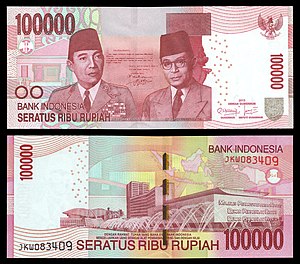
The
rupiah is the national currency of Indonesia. Introduced in 1946 by Indonesian nationalists
fighting for independence, the currency replaced a version of the
Netherlands Indies gulden which had been introduced during the
Japanese occupation in
World War II. In its early years the rupiah was used in conjunction with other currencies, including a new version of the gulden introduced by the Dutch. Since 1950, it has had a
lengthy history of inflation and revaluation. As of August 2018
[update], the currency—which is issued and controlled by the
Bank of Indonesia—is trading for more than 14,600 rupiah to the
United States dollar.
This note, denominated 100,000 rupiah, is from a 2011 revision of an earlier series. It depicts Sukarno and Mohammad Hatta, respectively Indonesia's first president and vice-president, on its obverse, and the People's Consultative Assembly building on its reverse.
See other denominations: Rp 1,000, Rp 2,000, Rp 5,000, Rp 10,000, Rp 20,000, Rp 50,000
Template:POTD/2019-03-15

Woman Reading a Letter is an oil-on-canvas painting by the Dutch painter
Johannes Vermeer, produced in around 1663. The central element of the painting is a woman in blue standing in front of an unseen window, reading a letter. The woman appears to be pregnant, although as pregnancy was rarely depicted in art during this period, some scholars have argued that the woman's rounded figure is simply a result of the fashions of the day. While the contents of the letter are not depicted, the composition of the painting is revealing. The map of the
Netherlands on the wall behind the woman has been interpreted as suggesting that the letter she reads was written by a traveling husband. Alternatively, the box of pearls barely visible on the table before the woman might suggest a lover, as pearls are sometimes a symbol of vanity. The painting is unique among Vermeer's interiors in that no fragment of corner, floor or ceiling can be seen. Part of the collection of the city of
Amsterdam as part of the
Van der Hoop bequest, it has been in the
Rijksmuseum since its inception.
Template:POTD/2019-09-18
Photograph credit: Max Büttinghausen; restored by Adam Cuerden Aletta Jacobs (1854–1929) was a Dutch physician and
women's suffrage activist. Jacobs strove throughout her life to change laws that limited women's access to equality, starting in 1883 with an unsuccessful court challenge and eventually achieving success 100 years ago today, on 18 September 1919, with the signing of a suffrage bill into law. She is also noted for founding the world's first birth control clinic, in 1882. As a child Jacobs yearned to become a doctor like her father and, despite existing barriers, she fought to gain entry to higher education and became the first woman officially to attend a Dutch university, and one of the first female physicians in the Netherlands. Providing medical services to women and children, she grew concerned over the health of working women, and although she continued to practice medicine until 1903, she increasingly turned her attention to activism with a view to improving women's lives. In addition to her suffrage work she led campaigns aimed at deregulating prostitution, improving women's working conditions, and promoting peace.
The Selected picture box on the portal chooses one of the following at random when displaying the page. Follow the instructions below for adding or nominating a new picture to the list.
Feel free to add related featured pictures to the list. Nominate other pictures on the portal talk page.
- Pictures must be
- Free to use and hosted on Commons
- Of good quality (not blurred, grainy or discoloured)
- Interesting
- Relevant to an article or topic
To find appropriate pictures, use search box below:
- For pictures, which appeared as picture of the day on the Main Page, just add the date in
YYYY-MM-DD format to the list (please keep the list sorted).
- For other pictures, use following parameters:
|iN=
|titleN=
|creditN=
|captionN=
where N is the next unused number.


